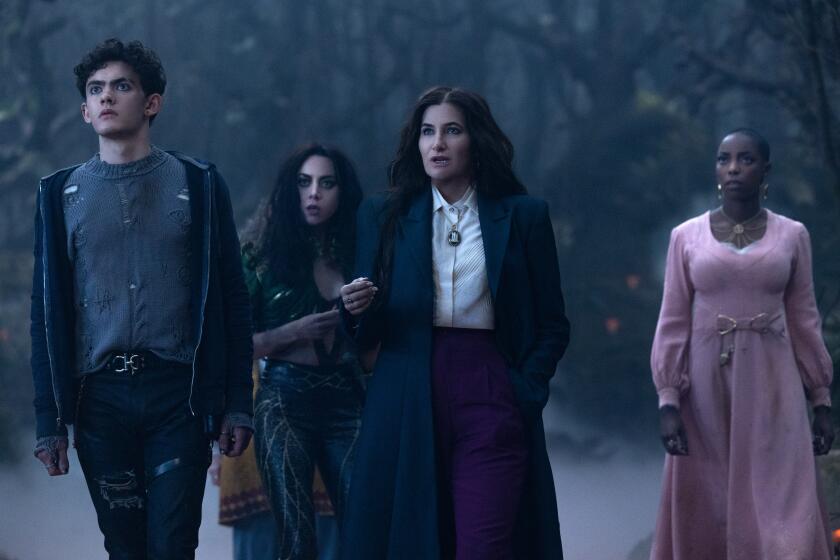Movie exhibitors welcome Foo Fighters to their screens, live and in 3-D
Stop by your local multiplex on a weekday night and you’ll pretty much have a private screening for the movie of your choice. Theater owners have been trying to combat this mid-week ghost-town effect in recent years with alternative programming concepts like screening major sports events and operas.
The latest twist in alternative programming will land in more than 80 digital cinemas for one night Tuesday: a new documentary about the post-grunge rockers the Foo Fighters with a special encore. In what’s touted as an industry first, the documentary “Foo Fighters: Back and Forth” will be followed immediately by a live, 3-D performance of “Wasting Light,” the band’s album arriving next week. Audience members will be able to text in extra song requests as the band plays.
At last week’s annual convention of theater owners in Las Vegas, exhibitors were still grappling with how to boost sagging movie attendance overall — admissions are off by some 20% so far this year. Many theaters generate only about 15% of their weekly business on school nights, but there are some signs of life. Non-movie presentations yielded $112 million in U.S. sales last year, according to a recent report in the trade publication Screen Digest, up nearly 52% from 2009. Almost half of that revenue was driven by the series “Met Opera: Live in HD,” which grossed a combined $48 million — more than many traditional Hollywood offerings, such as “Saw 3D,” Clint Eastwood’s “Hereafter” or “Cats & Dogs: The Revenge of Kitty Galore.”
But the new programming options can sometimes be costly--admissions for the Foo Fighters double bill run as high as $25. The band’s most ardent followers don’t seem to mind the premium, as several auditoriums already are fully booked — with hardly any paid advertising.
Jeremy Devine, the vice president of marketing and advertising for the 905-screen Rave Motion Pictures, says the chain has booked “Foo Fighters: Back and Forth” into about 60 of its theaters, including Rave Motion Pictures 18 in Westchester (the film is also playing at several other Southern California theaters, including Grauman’s Chinese Theatre). Because the chain is fully digital, Rave can add screens as interest builds.
“We can really react to the demand. That’s the beauty of digital cinema,” Devine said at last week’s CinemaCon. “Two or three shows have already sold out, mostly driven by the groups who follow Foo Fighters.”
The film, directed by Oscar-winning documentarian James Moll (“The Last Days”), probably won’t displace “The Last Waltz” or “Stop Making Sense” on the list of seminal pop music movies, but it does provide an interesting primer on the formation and evolution of the popular rockers. Initially conceived by Nirvana drummer Dave Grohl as a self-produced, one-man effort following the death of lead singer Kurt Cobain, Foo Fighters went on to experience any number of mutinies, defections and drug and alcohol overindulgences on its climb to stardom.
Owing to the mystique of Nirvana and Cobain, Foo Fighters’ every misstep was chronicled extensively. “We went through all of those embarrassing growing pains in public,” Grohl says in the film. Toward the end of the movie, the band makes its latest album at Grohl’s home, using analog tape instead of digital tools. It is that record that will be played front-to-back from a studio in the San Fernando Valley after the 7 p.m. Tuesday screenings. (The documentary and a recorded version of the album performance will be released together in about 250 theaters next week.)
Chris McGurk, whose Cinedigm Digital Cinema Corp. is delivering the documentary and performance, says theater owners are eager to find ways to generate revenue when their auditoriums are sitting empty between weekends. Cinedigm previously has done recorded concerts featuring the Dave Matthews Band, Bon Jovi, Phish and Beyoncé, along with live, 3-D sporting events such as the World Cup and college football and basketball championships.
With so many multiplexes now equipped with digital projectors and 3-D screens and glasses, live music makes sense, McGurk says. “It’s exactly the kind of thing you should be presenting in 3-D,” he adds. “It makes you feel like you’re in this little studio with the band.” To attract exhibition partners, Cinedigm offers a share of a show’s ancillary profits in exchange for marketing and promotional support.
McGurk said Cinedigm wants to create a series of programs — other companies have done live theater performances such as Danny Boyle’s London play “Frankenstein” and the Los Angeles Philharmonic’s “LA Phil Live” symphonies — that can spark subscription sales the way a season at the Hollywood Bowl does. “We want to move away from the one-offs and go to more programmatic series” like regular lectures or extreme sports offerings, McGurk says. Even if 3-D television sales accelerate, he says “the tribal, communal experience” of watching sports or music or theater with a group “will keep this going forward.”
But don’t expect these mid-week alternative offerings to push the latest “Pirates of the Caribbean,” “Transformers” or “Harry Potter” movies out of theaters on the weekend. Says Rave’s Devine: “I don’t think anything is going to supplant the Hollywood blockbusters.”
More to Read
The biggest entertainment stories
Get our big stories about Hollywood, film, television, music, arts, culture and more right in your inbox as soon as they publish.
You may occasionally receive promotional content from the Los Angeles Times.











